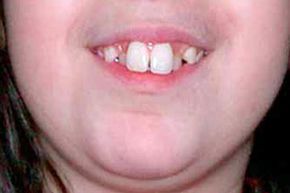A healthy, attractive smile is often characterized by even rows of nicely sized teeth. But sometimes, as teeth are developing and filling in the mouth and gum line, abnormalities occur and one or several teeth grow at a different rate than others. The condition, known as macrodontia, is when a tooth (or teeth) grows bigger than normal, and this difference in size is noticeable in comparison to surrounding teeth. While macrodontia isn't very common, most of us have probably seen someone whose smile is dominated by a large front tooth or incisor.
In dentistry and medicine, macrodontia is referred to as a dental anomaly or dental manifestation. It isn't considered a deformity but instead, a peculiarity in morphology -- or how the teeth grow and form [sources: Chussid; NIH; Yang]. Some alternate names for macrodontia are megadontia, megalodontia and gigantism [source: Chussid].
Advertisement
As an adult, you won't start to develop or "get" macrodontia. It forms while teeth are growing. Having a large tooth or teeth into adulthood is simply the result of allowing them to grow into place alongside the more normal-sized teeth. Compared to a more serious problem such as a cleft palate, which most often requires surgical intervention, macrodontia has fewer complications and less-invasive treatment options.
Not all cases of macrodontia require treatment, though many are repaired in order to avoid problems with the bite, dental cavities from irregular surfaces and the overall appearance of a person's smile. Adults with macrodontia generally have had it throughout childhood and adolescence and may have no difficulties as a result of the irregular tooth size.
Whether or not macrodontia is treated and how it's treated can depend on where and how it develops. We'll look at the different types of this dental anomaly next.
Advertisement


